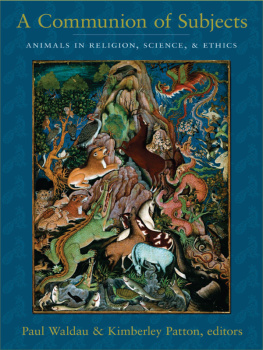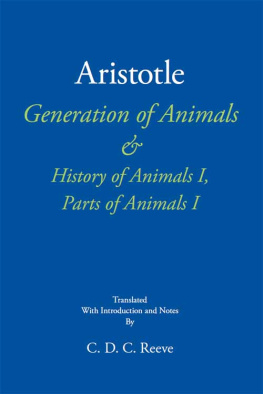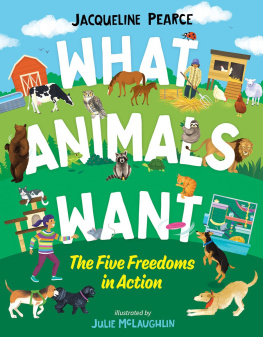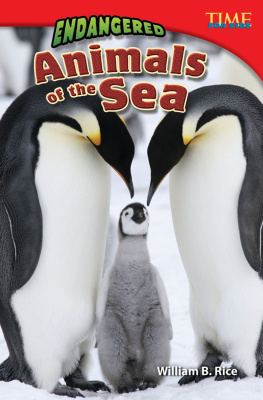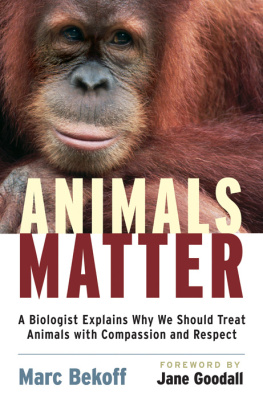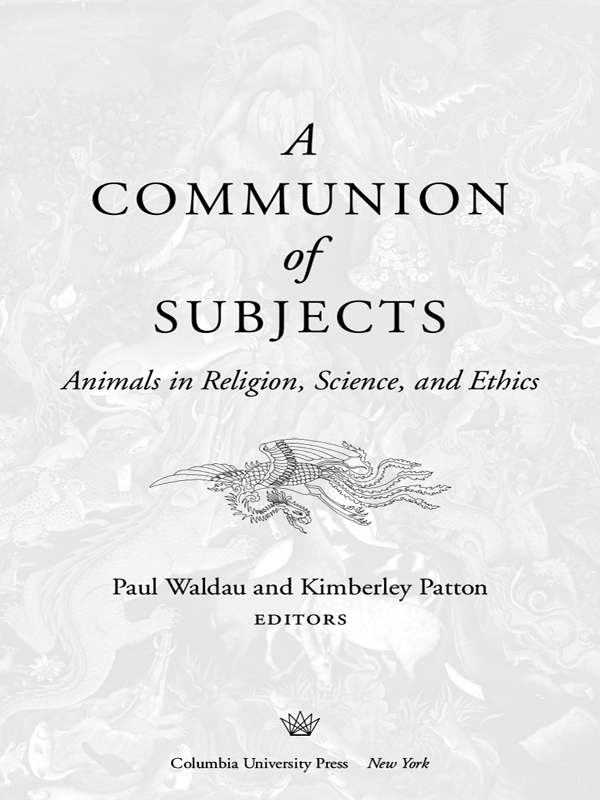A Communion of Subjects
Columbia University Press
Publishers Since 1893
New York, Chichester, West Sussex
cup.columbia.edu
Copyright 2006 Columbia University Press
All rights Reserved
E-ISBN 978-0-231-50997-8
Library of Congress Cataloging-in-Publication Data
A communion of subjects : animals in religion, science, and ethics /
Paul Waldau, and Kimberley Patton, editors.
p. cm.
Includes index.
ISBN 0-231-13642-0 (clothbound : alk. paper) ISBN 0-231-50997-9 (electronic)
1. AnimalsReligious aspects. I. Waldau, Paul. II. Patton, Kimberley C. (Kimberley Christine), 1958- BL 439.c66 2006
205.693-dc22 2006008168
A Columbia University Press E-book.
CUP would be pleased to hear about your reading experience with this e-book at .
References to Internet Web Sites (URLs) were accurate at the time of writing. Neither the author nor Columbia University Press is responsible for Web sites that may have expired or changed since the book was prepared
To Barley and Ryely, beloved golden dogs and to Emily, sweet rabbit
A communion unbroken
P.W. and K.C.P.
Indeed we must say that the universe is a communion of subjects rather than a collection of objects.
Thomas Berry
Contents
Animals in Religion, Science, and Ethics:
In and Out of Time
Caught with ourselves in the net of life and time:
Traditional Views of Animals in Religion
Seeing the Terrain We Walk:
Features of the Contemporary Landscape of Religion and Animals
Sacrifice in Ancient Israel:
Pure Bodies, Domesticated Animals, and the Divine Shepherd
Hope for the Animal Kingdom:
A Jewish Vision
Hierarchy, Kinship, and Responsibility:
The Jewish Relationship to the Animal World
The Bestiary of Heretics:
Imaging Medieval Christian Heresy with Insects and Animals
Practicing the Presence of God:
A Christian Approach to Animals
This she-camel of God is a sign to you:
Dimensions of Animals in Islamic Tradition and Muslim Culture
The Case of the Animals Versus Man:
Towards an Ecology of Being
Cows, Elephants, Dogs, and Other Lesser Embodiments of tman:
Reflections on Hindu Attitudes Toward Nonhuman Animals
Strategies of Vedic Subversion:
The Emergence of Vegetarianism in Post-Vedic India
A vast unsupervised recycling plant:
Animals and the Buddhist Cosmos
Snake-kings, Boars Heads, Deer Parks, Monkey Talk:
Animals as Transmitters and Transformers in Indian and Tibetan Buddhist Narratives
Inherent Value without Nostalgia:
Animals and the Jaina Tradition
Of a tawny bull we make offering:
Animals in Early Chinese Religion
Of Animals and Humans:
The Confucian Perspectiv
East Meets West:
Animals in Philosophy and Cultural History
Human Exceptionalism Versus Cultural Elitism:
(Or Three in the morning, four at night)
Humans and Animals:
The History from a Religio-Ecological Perspective
A Symbol in Search of an Object:
The Mythology of Horses in India
Why Umbulka Killed His Master:
Aboriginal Reconciliation and the Australian Wild Dog (Canis lupus dingo)
Knowing and Being Known by Animals:
Indigenous Perspectives on Personhood
Animal Sacrifice:
Metaphysics of the Sublimated Victim
Hunting the Wren:
A Sacred Bird in Ritual
Ridiculus Mus:
Of Mice and Men in Roman Thought
Raven Augury from Tibet to Alaska:
Dialects, Divine Agency, and the Birds-Eye View
Animals as Subjects:
Ethical Implications for Science
Caring for Farm Animals:
Pastoralist Ideals in an Industrialized World
Agriculture, Livestock, and Biotechnology:
Values, Profits, and Ethics
Contemporary Challenges:
Law, Social Justice, and the Environment
Animal Law and Animal Sacrifice:
Analysis of the U.S. Supreme Court Ruling on Santera Animal Sacrifice in Hialeah
A very rare and difficult thing:
Ecofeminism, Attention to Animal Suffering, and the Disappearance of the Subject
Interlocking Oppressions:
The Nature of Cruelty to Nonhuman Animals and its Relationship to Violence Toward Humans
The editors wish to thank the extraordinary group of contributors to this volume; their scholarship, insight, and humanity have offered us a humbling learning experience as we worked together with them through the years on A Communion of Subjects. To Thomas Berry, geologian and wise teacher, thank you for providing the inspiration that drew the various sectors of this book into communion and coherence. Our deep gratitude is due to Professors Mary Evelyn Tucker and John Grim, directors of the Forum on Religion and Ecology, and to Richard Clugston of the Center for Respect of Life and the Environment (CRLE) for their vision and leadership in the area of religion and ecology, and in particular for their support of the conference on Religion and Animals at Harvard University in 1999. Thanks to Professor Tu Wei-ming of Harvard University and to the Yen Ching Institute for their sponsorship of the same conference, which was the genesis for the present book. The funds for the production editing and for many of the illustrations and permissions were generously provided by the CRLE and the Religion and Animals Institute at Tufts School of Veterinary Medicine. Leslie Bialler, our valiant copyeditor at Columbia University Press, brought intelligence, care, and humor to a harrowing task. Finally, our heartfelt thanks to the wonderful Wendy Lochner, senior editor of religion and philosophy at Columbia University Press, whose profound interest in this project has been steadfast from the beginning, and whose encouragement has sustained us to the end.
To all the creatures of the earth, human and nonhuman, thank you for bearing witness to the complexity and power of life itself, as it is expressed in so many forms and subject to so many visions: religious, scientific, and ethical.
PAUL WALDAU AND KIMBERLEY PATTON
A very rare and difficult thing: Ecofeminism, Attention to Animal Suffering, and the Disappearance of the Subject
CAROL ADAMS
This ecofeminist exploration addresses two out-of-place cows and what they teach us about several interrelated issues regarding the religious imagination and human relations with nonhumans. The first cow was fashioned by filmmaker David Lynch for the Cow Parade, a collection of artily-painted sculptured bovines scattered throughout New York City. Lynchs painted cow, which had Eat My Fear written across its hacked, decapitated and disemboweled body, was on display only two and a half hours, but caused children to cry and subsequently was kept under wraps in a warehouse. The other cow, an actual cow, jumped a 6-foot fence in Cincinnati in the winter of 2002 to escape a meatpacking plant and then, until she was captured, ran free in a city park for 10 days. The day after Easter, she appeared in a parade that celebrated the start of the baseball season. Now called, Cinci Freedom, she received a key to the city as part of the citys festivities. She was then transported to an animal sanctuary to live out her natural life unmolested by meat packers, while many of the humans who celebrated her freedom headed to the ballpark to watch baseball and chomp down on some hot dogs. Ecofeminist insights offer assistance in unraveling the paradoxes concerning nonhuman suffering inherent in these stories. Specifically, these insights provide a conceptual understanding of the dualistic opposition between humans and nonhumans/animals, the issues of disembodied versus embodied responses to suffering, and the positive nature of grief as a response to the death of nonhumans. This essay also reviews the fruits of ecofeminist-animal rights theory, such as found in the authors application of the concepts absent referent and mass term to the fate of nonhuman animals to be consumed as food. It concludes by recommending the cultivation of attention to the suffering of non-humans.

